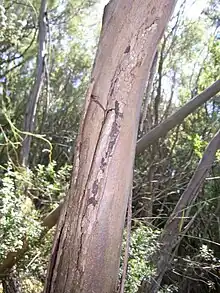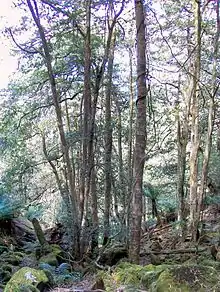| Mount Imlay National Park New South Wales | |
|---|---|
 Mount Imlay, 886 metres above sea level | |
 Mount Imlay National Park | |
| Nearest town or city | Eden |
| Coordinates | 37°10′48″S 149°44′06″E / 37.17994°S 149.73506°E |
| Established | 21 July 1972 |
| Area | 48 km2 (18.5 sq mi) |
| Managing authorities | NSW National Parks and Wildlife Service |
| Website | Mount Imlay National Park |
| See also | Protected areas of New South Wales |
Mount Imlay is a national park in New South Wales (Australia), 387 km south of Sydney, named after the Imlay brothers, who were early pioneers to the district.[1] It is accessed from the Princes Highway, south of Eden, New South Wales. The local Aborigines call the mountain "Balawan", and it is very important for their culture and spiritual teachings.[2]
The vegetation is mostly eucalyptus forest. The Imlay Mallee and Imlay Boronia are rare plants growing near the mountain's summit. However, there is a 2-hectare (4.9-acre) rainforest remnant surviving in a fire-free gully. It consists mostly of Black Olive Berry trees. The park contains large populations of wombats and superb lyrebirds.
Geology
Most of Mt Imlay National Park was formed during the Ordovician Period, 500 to 435 million years ago, from sedimentary and metamorphosed rocks of the Mallacoota Beds, part of the Southern Highlands Fold Belt, including greywacke, sandstone and shale. The summit of Mt Imlay and the upper slopes are younger, with Devonian (395 to 345 Million years ago) rocks of the Merimbula Group, lying above the Ordovician sediments. The Merimbula Group includes sandstone, conglomerates, quartzite, siltstone and shale. Quaternary sediments form narrow river flats along the Towamba River on the northern edge of the park.
See also
Mount Imlay Photos
 the critically endangered Imlay Mallee
the critically endangered Imlay Mallee White Ash & sandstone below the high ridge at Mount Imlay
White Ash & sandstone below the high ridge at Mount Imlay the rare Imlay Boronia near the mountain's summit
the rare Imlay Boronia near the mountain's summit Gully Rainforest at Mount Imlay with the Black Olive Berry
Gully Rainforest at Mount Imlay with the Black Olive Berry
References
- ↑
- The main street of Eden, New South Wales is named Imlay Street.
- ↑ "Mount Imlay National Park | Learn more". NSW National Parks. Retrieved 9 November 2021.
External links